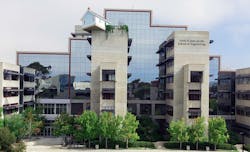$30 million gift from alumnus will help pay for engineering facility at University of California San Diego
The co-founder of Qualcomm is donating $30 million to the University of California San Diego to help pay for an additional facility for the university's Jacobs School of Engineering.
In recognition of the gift from Franklin Antonio, a UC San Diego alumnus who co-founded the semiconductor and telecommunications equipment company in 1985, the university will name a building for engineering research and education, now in the planning stages, Franklin Antonio Hall.
UC San Diego says in a news release that the 200,000-square-foot building is being designed to facilitate cross-discipline collaborations and work on the health, energy, autonomy and security challenges facing society. Franklin Antonio Hall is scheduled to open by fall 2021.
“We are so grateful to Franklin Antonio for his incredible generosity to UC San Diego,” says Chancellor Pradeep K. Khosla. “Mr. Antonio is a remarkable alumnus and visionary who has made transformational technological advances that have touched each of our lives. With this gift, he is now making a significant impact on the campus and beyond, fueling future research, collaboration and discoveries that will have a positive impact around the globe.”
Franklin Antonio Hall, which is being designed to meet LEED Platinum environmental standards, will provide the Jacobs School of Engineering with spaces to accommodate the School’s ambitious growth. In the last four years, the Jacobs School has hired more than 75 professors and increased its graduate student population to 2,272 from 1,715.
Eleven collaborative research spaces, dubbed “collaboratories,” will make up the heart of Franklin Antonio Hall. Each collaboratory will house five to seven professors – and their respective research groups.
The professors within each collaboratory will come from a mix of different academic departments within the engineering school. Co-locating diverse yet complementary research groups will encourage the interdisciplinary systems-level collaborations necessary for solving challenges.
In addition to the eleven collaboratories, the building design includes plans for:
- A 250-seat auditorium for teaching classes
- Executive education spaces including facilities optimized for online teaching and learning as well as facilities for the master’s programs for engineers who are already in the technical workforce.
- Flexible meeting spaces for industry-academia collaborations
- A high-bay laboratory with flexible research space for projects that require high ceilings and access to the building’s loading dock
- Multipurpose classrooms, faculty offices, meeting rooms and a café.
The engineering school in named for Irwin Jacobs, another co-founder of Qualcomm, who gave the program $110 million in 2003.
The San Diego Union-Tribune says Antonio’s $30 million gift is the second largest donation ever made by one of the university’s alumni. It comes nine months after alumnus Taner Halicioglu, who helped to create Facebook, gave the school $75 million for a data science institute.
About the Author
Mike Kennedy
Senior Editor
Mike Kennedy, senior editor, has written for AS&U on a wide range of educational issues since 1999.
